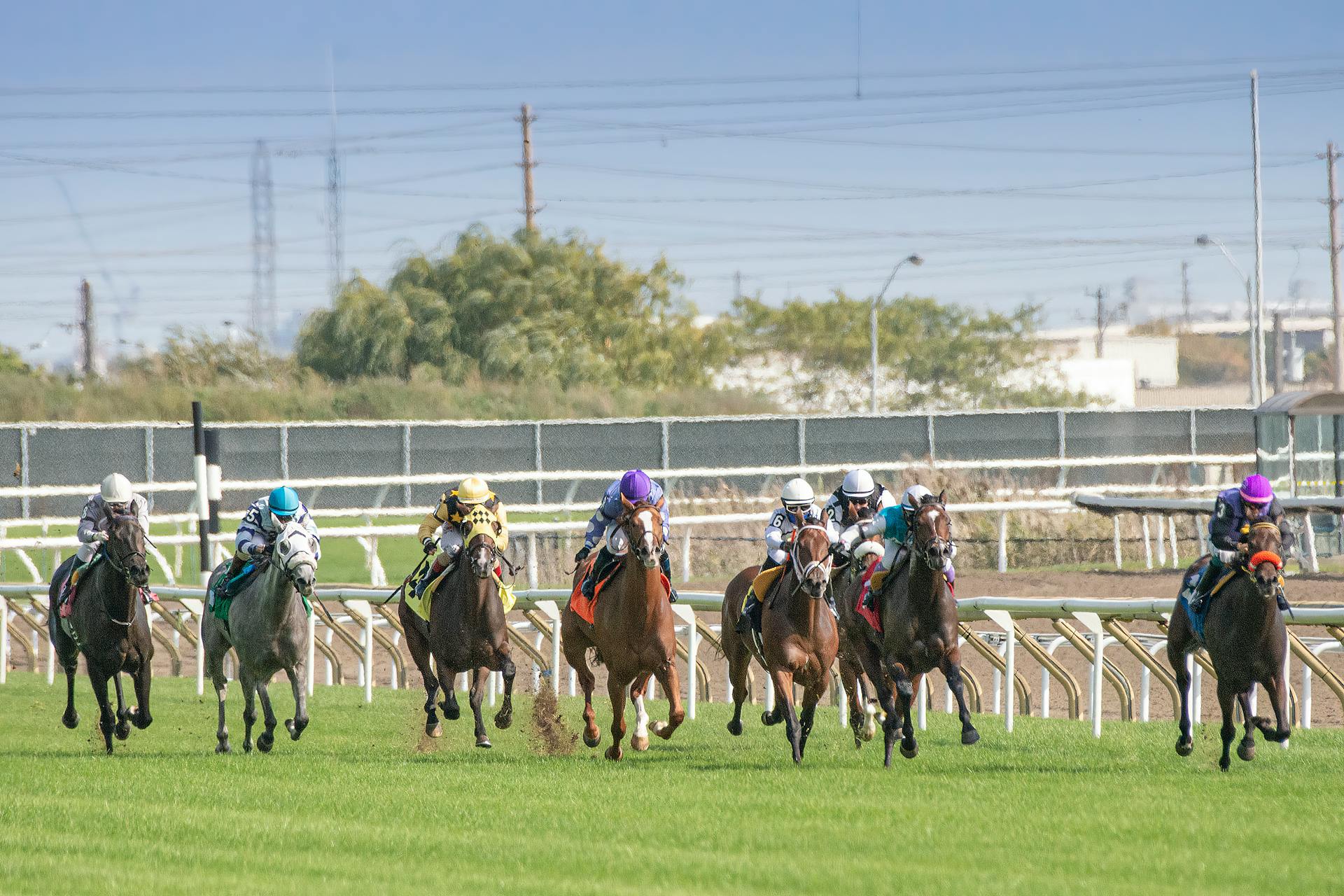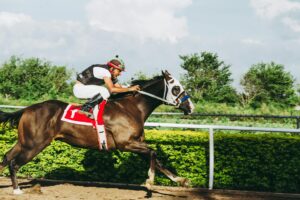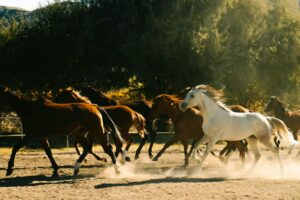An Introduction to Thoroughbred Racing
Thoroughbred racing is a prominent equestrian sport with a rich history that traces back to the early 17th century. Originating in England, it has become one of the most popular and prestigious forms of horse racing worldwide. The sport’s roots lie in the breeding of three foundation stallions—Byerley Turk, Darley Arabian, and Godolphin Arabian—with various mare lines, which resulted in the thoroughbred horse breed renowned for its speed, agility, and stamina.
Thoroughbred horses are characterized by their tall and slender frames, athletic build, and long legs, allowing them to reach impressive speeds on the racetrack. These horses generally stand between 15.2 to 17.2 hands high and are known for their distinctive coat colors, which range from bay, black, chestnut, to gray. The breed’s physical attributes, coupled with their strong work ethic and competitive spirit, make them ideal candidates for racing events. Furthermore, thoroughbreds are celebrated for their intelligence and trainability, critical traits that contribute to their success in various equestrian disciplines beyond racing.
The excitement of thoroughbred racing extends well beyond the races themselves, as it encompasses the entire culture surrounding the sport. This includes breeding operations, training facilities, and even the betting and entertainment aspects that engage fans globally. Major races such as the Kentucky Derby, Preakness Stakes, and Belmont Stakes form part of the Triple Crown series, attracting significant media attention and viewership. The sport not only showcases the athleticism of thoroughbreds but also highlights the dedication and expertise of trainers, jockeys, and owners. As a result, thoroughbred racing has solidified its status as an integral component of equestrian sports, celebrating both tradition and innovation to captivate audiences for generations.
The Types of Thoroughbred Races
Thoroughbred racing is a captivating sport that presents various competition types, notably flat racing, steeplechase, and harness racing. Each of these race types possesses distinctive characteristics that contribute to their unique appeal, rules, and demands on both horses and jockeys.
Flat racing is the most prevalent form of thoroughbred racing, conducted on a level track without any obstacles. These races are typically run over distances ranging from five furlongs to a mile and a half. Horses participating in flat races are required to exhibit exceptional speed and stamina, relying on the jockey’s expertise in pacing and positioning to maximize performance. The absence of barriers means that strategic maneuvers and agility play a crucial role in gaining an advantage during the race.
In contrast, steeplechase racing introduces a series of hurdles and fences that horses must navigate while maintaining a competitive speed. This type of race is designed to evaluate not only the horse’s speed but also its jumping ability and endurance. Steeplechase races often cover longer distances compared to flat races and require both horses and jockeys to possess a high degree of coordination and skill. The challenges of jumping over obstacles demand a distinctive training regimen, where horses develop strength and agility to effectively clear jumps.
Harness racing presents another unique type of thoroughbred competition, which involves horses pulling a two-wheeled sulky cart driven by a jockey. Unlike flat and steeplechase racing, harness racing requires the horses to maintain a specific gait, typically a trot or pace. This race form emphasizes the horse’s ability to maintain speed while pulling a driver seated in the cart. Races are staged on oval tracks, and the rules governing these competitions dictate the importance of not breaking stride. As a result, harness racing places unique demands on the horse’s conformation and training methods, differentiating it from other racing types.
Understanding the different types of thoroughbred races is essential for appreciating the complexities of the sport. Each variety offers its own set of challenges and excitement, making thoroughbred racing a multifaceted and engaging pursuit.
The Role of Jockeys and Trainers
In the world of thoroughbred racing, jockeys and trainers play pivotal roles that significantly affect both the performance of the horse and the outcome of races. Trainers are primarily responsible for the comprehensive training regimen of the horses under their care. This extensive preparation encompasses various aspects including physical fitness, dietary needs, and mental conditioning. Trainers typically devise tailored training programs that focus on building stamina, speed, and agility. Moreover, they continuously assess the horse’s progress and make necessary adjustments to their training approaches to ensure the horses are race-ready.
Furthermore, the trainers’ responsibilities extend beyond mere physical conditioning. They also handle logistical preparations, such as arranging travel for the horses and ensuring they are in peak condition on race day. A strong relationship between a trainer and their horse is crucial for success, as mutual trust enhances the horse’s performance. On the other hand, jockeys are the athletes who ride the horses during races. Their role encompasses not just the physical act of riding, but also strategic decision-making that can alter a race’s outcome.
Jockeys must possess a deep understanding of both their horse’s capabilities and various race conditions. This knowledge allows them to make split-second decisions regarding pace, positioning, and responding to competitors. Effective communication between jockeys and trainers is essential; trainers often provide insights into the horse’s strengths and weaknesses, enabling jockeys to adjust their tactics accordingly. This collaborative dynamic is fundamental to achieving success in thoroughbred racing, as both the jockey and trainer work together towards the common goal of winning. Overall, the synergy between trainers’ preparations and jockeys’ execution is fundamental in maximizing the performance and potential of thoroughbreds on race day.
Understanding Racecourses and Betting
Thoroughbred racing takes place at specifically designed racecourses that vary in layout and surface types. These racecourses can be broadly classified into two categories: turf and dirt tracks. Turf tracks are made of natural grass and are preferred for certain races due to their softer surface, which is believed to be easier on the horses’ legs. In contrast, dirt tracks are composed of a mixture of sand, clay, and other materials, providing a firmer surface that can impact race speed. Each surface type profoundly influences a horse’s performance, making it essential for bettors to consider these factors when analyzing races.
In addition to understanding the physical characteristics of racecourses, it is important to familiarize oneself with the various betting options available. Betting on thoroughbred races can be an exciting endeavor, but it requires knowledge of several types of wagers. The most common type of bet is the “win” bet, where a bettor selects a horse to finish first. There are also “place” and “show” bets, which are wagers placed on a horse to finish either second or third, respectively. More advanced betting options include exactas, trifectas, and superfectas, where bettors must predict the finishing order of multiple horses. Understanding these betting types is crucial for both novice and seasoned bettors looking to make informed decisions.
Furthermore, it is essential to comprehend race odds and how to interpret race charts. Race odds are indicators of the likelihood of a horse winning a race, and they fluctuate based on various factors, including betting volume and horse performance. Reading race charts can reveal valuable insights, such as a horse’s recent performance, the conditions of the race, and the history of the horse and jockey. Thus, a thorough understanding of racecourses and the betting landscape enriches the overall experience of thoroughbred racing, allowing enthusiasts to engage more fully in this captivating sport.
Key Events in Thoroughbred Racing
Thoroughbred racing, a sport steeped in tradition and excitement, features a variety of key events that captivate fans and participants alike. Among the leading races is the Kentucky Derby, often referred to as “The Most Exciting Two Minutes in Sports.” Held annually on the first Saturday in May at Churchill Downs in Louisville, Kentucky, this race has a storied history dating back to 1875. The Kentucky Derby showcases three-year-old thoroughbreds competing for a coveted place in racing history and has become a cultural phenomenon, drawing spectators in stunning attire and significant media attention.
Another important event on the thoroughbred calendar is the Breeders’ Cup, a series of championship races that take place over two days in early November. Established in 1984, the Breeders’ Cup features top thoroughbreds from North America and around the globe vying for rich purses and prestigious titles. This event not only highlights the elite of the sport, but it also introduces fans to a diverse range of races, including the Breeders’ Cup Classic, which is regarded as the pinnacle of the thoroughbred racing season.
On an international scale, the Dubai World Cup stands out as a premier event. Inaugurated in 1996, it has rapidly gained recognition for its substantial prize money, making it one of the richest horse races in the world. The Dubai World Cup attracts elite thoroughbreds from various countries, illustrating the global appeal of the sport. Held at Meydan Racecourse in the United Arab Emirates, this event draws considerable attention and enhances the reputation of thoroughbred racing as a thrilling spectacle.
These key events not only celebrate the athletic prowess of thoroughbreds but also contribute to the sport’s rich legacy, providing unforgettable experiences for fans, owners, and trainers alike. Each event plays a significant role in defining the essence of thoroughbred racing, highlighting its vibrancy and continuing appeal.
The Evolution of Thoroughbred Racing
Thoroughbred racing has a rich history that spans several centuries, evolving significantly from its early beginnings into the modern spectacle it is today. This evolution has been influenced by a variety of factors, including technological advancements, regulatory changes, and the rising popularity of wagering. Initially, horse racing can be traced back to ancient civilizations, but it was in the 17th century, particularly in England, that the breed we now recognize as the thoroughbred began to take shape. The introduction of breeding practices aimed at enhancing speed and agility marked the start of a new era in horse racing.
As the sport gained popularity, the establishment of formalized rules and governing bodies became essential. Organizations such as the Jockey Club, founded in 1750, helped standardize guidelines and create a framework for the sport. These developments not only promoted fairness but also established the credibility of thoroughbred racing, attracting a broader audience. With the advent of the internet and digital technologies in the late 20th century, thoroughbred racing experienced another transformative phase. Online wagering has made it increasingly accessible for fans worldwide, contributing to an upsurge in interest and participation.
The regulatory landscape has also seen significant shifts; measures aimed at ensuring animal welfare and the integrity of the sport continue to evolve. Stricter drug testing and safety protocols have been instituted to protect both equine athletes and their jockeys. Furthermore, social media and streaming platforms have reshaped how races are broadcast, enhancing viewer engagement and bringing live events directly to fans’ screens. As we look toward the future, the continued integration of technology in thoroughbred racing, along with new regulatory measures, will likely play a vital role in maintaining the sport’s appeal and integrity, influencing how a new generation of fans appreciates thoroughbred racing.
The Emotional Connection: Stories from the Track
Thoroughbred racing is not merely a sport; it is an intricate tapestry woven with stories of triumph, heartache, and an indelible bond between humans and their equine counterparts. Among the countless narratives that shape this vibrant world, one tale stands out: that of Secretariat, the horse often hailed as the greatest racehorse in history. His astonishing performance during the 1973 Belmont Stakes, where he won by an unprecedented 31 lengths, is not just a statistic; it is a symbol of aspiration and perseverance. The image of Secretariat crossing the finish line still resonates with fans and serves as a reminder of the exhilarating highs that thoroughbred racing can offer.
This sport also reveals the profound relationships formed between jockeys and their mounts. Consider the story of the legendary jockey Bill Shoemaker, who forged an unparalleled connection with a range of extraordinary horses throughout his career. Each ride was more than a competition; it was a partnership built on trust and mutual understanding. The moments of joy, frustration, and heartwarming solidarity culminate in a shared experience that embodies the essence of thoroughbred racing. Jockeys often describe how they intuitively sense their horse’s emotions during a race, creating a bond that transcends words.
Moreover, the role of trainers cannot be overlooked. A trainer’s dedication to nurturing a horse from its early life to international glory is a testament to their unwavering commitment to the sport. Take, for instance, the story of Frankel, whose impeccable record of 14 wins remains unmatched. His trainer, Sir Henry Cecil, not only shaped Frankel’s racing career but also experienced an emotional journey filled with challenges. The deep respect and affection between them illustrate the unique human-animal connection that exists in thoroughbred racing, making it an emotionally rich sport for participants and spectators alike.
Safety and Welfare in Thoroughbred Racing
Thoroughbred racing is not only an exhilarating sport but also one that prioritizes the safety and welfare of its equine athletes and the jockeys who ride them. Regulatory bodies and racing organizations are dedicated to implementing stringent measures to ensure that all participants are protected during races. One fundamental aspect of this commitment is the establishment of comprehensive safety regulations that govern various implications of horse racing, including track conditions, equipment usage, and race protocols.
Veterinary care plays a critical role in maintaining the health and safety of thoroughbred horses. Before being allowed to race, each horse undergoes thorough pre-race examinations to assess their condition and readiness. This can include assessing their overall health, mobility, and any pre-existing issues that may affect performance. Such vigilant assessments help minimize the risk of injury during the race. Furthermore, post-race veterinary inspections are equally important, ensuring that any signs of distress or injury are promptly addressed. The availability of on-site veterinary teams during races further underscores the dedication to the health and welfare of the horses.
In addition to regulatory measures and veterinary care, numerous organizations actively promote safe practices in thoroughbred racing. These entities work in collaboration with trainers, owners, and jockeys to educate and enforce guidelines aimed at improving overall safety standards. For instance, initiatives such as training programs focus on injury prevention strategies, proper handling of horses, and the importance of using appropriate gear. Moreover, ongoing research into equine health contributes valuable insights that lead to enhanced welfare practices, ensuring that the commitment to the safety of both horses and riders remains unwavering.
How to Get Involved in Thoroughbred Racing
Thoroughbred racing is a captivating sport, enticing both spectators and participants with its rich traditions and vibrant community. For those interested in diving into this exhilarating world, there are several avenues to explore. Attending races is the most direct way to experience the thrill first-hand. Many tracks around the country host regular events, offering a range of amenities from hospitality suites to general admission seating. Engaging in this lively atmosphere allows one to appreciate the dedication of the horses and the skill of the jockeys while also offering a chance to meet fellow enthusiasts.
For those seeking a more personal connection to the sport, becoming an owner or breeder presents an exciting opportunity. Ownership, whether through full ownership or partnerships, allows individuals to experience the unique bond with these magnificent animals. Aspiring owners should connect with experienced trainers and bloodstock agents who can provide valuable insights into purchasing and caring for thoroughbreds. Similarly, breeding horses can be rewarding for those interested in the science and art behind producing swift and successful racehorses. This process often involves understanding genetics and investing in quality mares and stallions.
Additionally, for individuals who wish to gain riding skills, arranging lessons with professional trainers is a fantastic step. Many training facilities offer lessons tailored for various skill levels and can provide a pathway into the racing scene. These lessons not only teach riding techniques but also impart vital knowledge regarding horse care and racing strategies.
Finally, immersing oneself in local racing communities can greatly enhance the experience. Volunteering at events, joining racing clubs, or participating in discussions online can help foster lasting connections while enriching one’s understanding of this thrilling equestrian sport. Whether as a spectator, owner, or rider, the path to engaging in thoroughbred racing is accessible and full of adventure.




